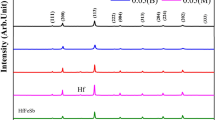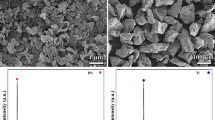Abstract
The following test methods have been applied: four-point bending, uniaxial compression, hardness measurement, and fractography to establish the regularities and mechanisms in deformation, work hardening, and failure in the temperature range 20-1300°C for a nanolaminate representative: porous titanosilicon carbide Ti3SiC2 made by solid-state reactive sintering. The temperature and deformation bounds to its existence in the plastic state have been established. A model is proposed for the deformation and failure. The results are compared with those for the compact material of the same stoichiometry.
Similar content being viewed by others
REFERENCES
M. W. Barsoum, “The M N + 1AXN phases: A new class of solids. Thermodynamically stable nanolaminates, ” Prog. Solid St. Chem., 28, 201–281 (2000).
M. W. Barsoum, T. El-Raghy, and M. Radovic, “Ti3SiC2: A layered machinable ductile carbide, ” Interceram., 49, No. 4, 226–233 (2000).
W. Jeitschko, H. Nowotny, and F. Benesovsky, “Kohlenstoffhaltige ternare Verbindungen (H-Phase), ” Monatsch. Chem., 94, 672 (1963).
W. Jeitschko and H. Nowotny, “Die Kristallstructur von Ti3SiC2: Ein Neuer Komplexcarbid-Type, ” Monatsch Chem., 98, 329–337 (1967).
H. Nowotny, “Struktuchemie einiger Verbindungen der Ubergangsmetalle mit den Elementen C, Si, Ge, Sn, ” Prog. Solid State Chem., 2, 27 (1970).
R. Pampuch, J. Lis, L. Stobierski, and M. Tymkiewicz, “Solid combustion synthesis of Ti3SiC2, ” J. Eur. Ceram. Soc., 5, 283 (1989).
J. Lis, R. Pampuch, J. Piekarczyk, and L. Stobierski, “New ceramics based on Ti3SiC2, ” Ceramics Int., 19, 219 (1993).
T. Okano, T. Yano, and T. Iseki, “Synthesis and mechanical properties of Ti3SiC2, ” Trans. Met. Soc. Jap., 14A, 597 (1993).
J. F. Li, W. Pan, F. Sato, and R. Watanabe, “Mechanical properties of polycrystalline Ti3SiC2 at ambient and elevated temperatures, ” Acta Mater., 49, 937–945 (2001).
A. N. Demidik, I. I. Ivanova, and O. M. Ivasishin, A Method of Making Components from Titanium Aluminide, Pat. 12529A Ukraine, Publ. 1997.
V. I. Trefilov, V. F. Moiseev, E. P. Pechkovskii, et al., Work Hardening and Failure in Polycrystalline Metals [in Russian], Nauk. Dumka, Kiev (1989).
S. Firstov and Yu. Podrezov, “Optimization of mechanical properties of porous materials, ” Powder Metall Progr., No. 1, 5–18 (2001).
P. I. Polukhin, S. S. Gorelik, and V. K. Vorontsov, The Physical Principles of Plastic Strain [in Russian], Metallurgiya, Moscow (1982).
V. I. Trefilov, Yu. V. Mil'man, and S. A. Firstov, The Physical Principles of Strength in Refractory Metals [in Russian], Nauk. Dumka, Kiev (1975).
V. A. Borisenko, Hardness and Strength in Refractory Materials at High Temperatures [in Russian], Nauk. Dumka, Kiev (1984).
Author information
Authors and Affiliations
Corresponding author
Rights and permissions
About this article
Cite this article
Pechkovskii, É.P., Firstov, S.A. Structure and Mechanical Properties of Porous Titanosilicon Carbide Ti3SiC2 . Powder Metallurgy and Metal Ceramics 42, 424–432 (2003). https://doi.org/10.1023/B:PMMC.0000004164.63420.14
Issue Date:
DOI: https://doi.org/10.1023/B:PMMC.0000004164.63420.14




